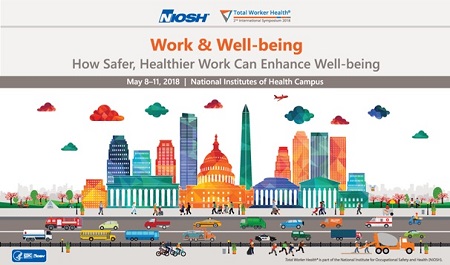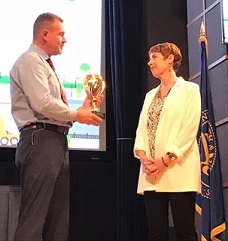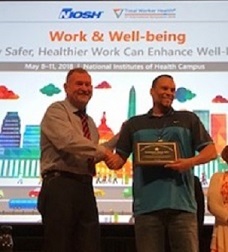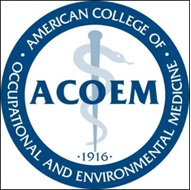Total Worker Health in Action: June 2018
Advancing worker safety, health, and well-being
Volume 7 Number 2 June 2018
Director’s Buzz
L. Casey Chosewood, MD, MPH

The Total Worker Health (TWH) team is still celebrating the success of the 2nd International Symposium to Advance Total Worker Health® which was held May 8-11th on the campus of the National Institutes of Health. We are elated that so many of you, or representatives from your organizations, could join us. The expanded Symposium highlighted 4 years of new research, new interventions, and new partnerships in the field of TWH. More than 100 presenters shared the latest science on TWH and integrated practices, providing more than 70 hours of unique instructional content.

We welcomed almost 400 participants from 15 countries. About 15% of attendees were from countries outside the United States, providing global perspectives and novel insights. I’d like to personally thank all who attended. I enjoyed sharing the time with you.
I’d also like to thank the following:
- Our NIOSH Total Worker Health Centers of Excellence, whose research has largely contributed to moving the field of TWH forward (Take a look at 19 of their latest research findings and publications below!)
- Team members at our NIOSH Office for TWH, who contributed their time and energy to making this week possible
- My symposium co-chair, Dr. Adele Childress, whose coordination and planning were instrumental in the symposium’s success
- Our partners at the Eagleson Institute, for their dedication to the logistical execution of the symposium and for serving our attendees so thoughtfully and professionally
- The National Institutes of Health (NIH), for hosting us on their campus and for the variety and quality of health and well-being activities offered throughout the course of the symposium.
We took time during the symposium for an inaugural awards ceremony to recognize three individuals with the following newly created awards for their outstanding and multi-year commitments and contributions to advancing the concept of Total Worker Health.



- The TWH Founder’s Award – Since its inception in 2011, the Total Worker Health program has benefitted from strong support from NIOSH’s own director, Dr. John Howard. His influence is a powerful energy to our program’s success. It’s only fitting that we named the inaugural and enduring award for luminaries in the field of TWH as deserving of the TWH Founder’s Award.
- For her tireless efforts in helping others understand the value of Total Worker Health approaches, we recognized Dr. Anita Schill as an inaugural recipient of this award. By offering energy, spirit, and grace, and by championing safety, health, and well-being for every worker in all endeavors over a rich and vibrant career, this leader spent decades making work safer for workers around the world.
- For his foundational leadership to the TWH Program and his endless dedication to the safety, health, and well-being of workers the world over, we recognized Dr. Martin Cherniack with the Total Worker Health Founder’s Award. Dr. Cherniack is a physician and professor of medicine at the University of Connecticut School of Medicine and director of the Ergonomic Technology Center. He has directed numerous NIOSH-funded research projects as well as participated in multi-center clinical intervention studies.
- The TWH Star Partner Award – For exceptional leadership, professional service, and steadfastness in advancing the NIOSH TWH Program, NIH’s Chris Gaines received the TWH Star Partner Award. Every aspect of the symposium was touched in a very personal way by this amazing individual and he has offered immeasurable support to the TWH program.
From our team’s standpoint, the symposium was extraordinary. With the highest number of presenters and participants ever convened for the topic of TWH, we had over 37 states represented, 70 pre-symposium workshop attendees, and 170 abstracts submitted. Presenters spoke on nearly every traditional occupational safety and health topic as well as dozens of late-breaking talks on emerging risks, the new economy, and the powers and perils of technology.
We heard from our new, young, dynamic Surgeon General Dr. Jerome Adams, who inspired us to see worker health as an essential priority for a better, more prosperous nation. He made it clear that he understands that good work is critical to our families and our communities. His passion about the opioid crisis is clearly personal and hopefully will motivate all of us to do more in our own organizations to address it.
Attendees had the treat hearing from Dame Carol Black—truly occupational safety and health royalty. Her clarion call for us to do more for mental health challenges facing workers, often directly from or exacerbated by challenging working conditions, resonated loudly and clearly.
We visited the inspiring Blue Zones together in Mr. Tony Buettner’s address and gained global insights from Mr. Hans-Horst Konkolewsky of ISSA. Thursday’s final keynote address from Zen Buddha teacher, physician, and Harvard professor Dr. Robert Waldinger prompted me to reflect on my own work’s fulfillment and my amazing team. I too hope that our participants will take a moment to view their own lives through his words of optimism and encouragement. While I was sad to see the insights of the week come to an end, I leave you with a few final takeaways shared during the week:
- Work, as a force for both challenge and opportunity, matters now more than ever before
- Work is changing, and with its shifting winds, our individual and collective health hangs in the balance
- New paradigms and novel approaches for advancing worker safety, health, and well-being are necessary
- TWH approaches are increasingly showing promise and can be part of the solution to the complex challenges and exciting opportunities facing today’s workers
We cannot advance TWH or realize its full potential alone. Partnerships and collaborations are essential if we wish to improve worker safety, health, and well-being. We look forward to working with each of you in the years that lie ahead.
To find abstracts, information on continuing education, or other symposium details, please visit the official website of the symposium. Find highlights on Twitter by searching #TWH2018.
We invite you to stay up-to-date on the latest Total Worker Health news, research, events, and more by joining the conversation on Twitter (@NIOSH_TWH), on the NIOSH Total Worker Health LinkedIn Group, or by email at twh@cdc.gov.
Updates from the NIOSH Office for Total Worker Health
RETAIN Phase 1 Funding Opportunity Announced
The Office for TWH has been asked by our colleagues at The Office of Disability Employment Policy (ODEP) at the U.S. Department of Labor (DOL) to alert our stakeholders to an important opportunity to help workers stay on the job or return to work after injury or illness. A recently published Funding Opportunity Announcement (FOA) for Phase 1 of the Retaining Employment and Talent after Injury/Illness Network (RETAIN) Demonstration Projects is now available. A partnership between the Social Security Administration and DOL’s Employment and Training Administration and ODEP, RETAIN will test the impact of early intervention strategies that improve stay-at-work/return-to-work outcomes for individuals who experience an injury or illness while employed. RETAIN projects will address both on-the-job and off-the-job injuries and illnesses and will be funded in two phases. During Phase 1, up to $20 million will be available for approximately eight states to complete planning and start-up activities and launch a pilot. Pending the availability of funding, at the end of 18 months up to four Phase 1 awardees will competitively receive up to $19.75 million each to implement RETAIN projects at full scale. Applications for Phase 1 are due on July 23, 2018. Additional information about RETAIN can be found on the Department of Labor’s website. The FOA is published on grants.gov.
Call for Papers for Special Journal Issue on TWH
Did you present at the 2018 TWH symposium? Are you interested in having your work published? The International Journal of Environmental Research and Public Health is accepting manuscripts for a special issue, “Using Total Worker Health to Advance Worker Health and Safety.” The special issue will be edited by Drs. Diane Rohlman and Kevin Kelly, of the Healthier Workforce Center of the Midwest. Deadline for manuscript submissions is October 8, 2018. For more information, including relevant topics, key words, and the submission process, please visit the special issue’s information page, or contact Dr. Rohlman at diane-rohlman@uiowa.edu.

July 24rd NIOSH Total Worker Health Webinar
Join us for a special NIOSH Total Worker Health and NIOSH Center for Workers’ Compensation Studies (CWCS) webinar titled Integrating Functional Outcomes with Clinical Measures on Tuesday, July 24, 1-2:30 pm Eastern, in which Dr. Kathryn Mueller and Dr. T. Warner Hudson will explore the benefits of integrating functional outcomes with clinical process measures as a basic approach to patient care in the US. By developing better ways to measure and optimize functional outcomes, organizations and occupational safety and health providers can better address the challenges faced by workers with disability after injury or illness. A preventive approach based in Total Worker Health concepts may help mitigate risk factors, both from work and home, which often slow the return to productive work. Registration is now open via Adobe Connect. Continuing Education credits for this activity are pending.
Spotlight on NIOSH Fundamentals of Total Worker Health Approaches

Editors’ note: In this and past editions of TWH in Action!, we take a closer look at the fundamental elements of the TWH approach. Today we look at…
Defining Element 5: Integrate Relevant Systems to Advance Worker Well-Being
Historically, many of the issues and topics of relevance to TWH either have been addressed by departments that work independently from one another or have not been addressed at all. This element stresses the importance of integrating and coordinating processes, data systems, and program activities across departments to avoid overlap and more efficiently address workers’ safety and health. To learn more about ways to break down organizational silos, align efforts across organizational divides, and bring systems and process together on your organization’s path toward Total Worker Health, visit the Fundamentals of TWH Approaches webpage.
News from our NIOSH TWH Affiliates and Partners
Join us in welcoming a new NIOSH TWH Affiliate!

The American College of Occupational and Environmental Medicine (ACOEM) is the nation’s largest medical society dedicated to promoting the health of workers through preventive medicine, clinical care, research, and education. Founded in 1916, ACOEM is a physician-led organization that represents more than 4,000 physicians and other health care professionals who specialize in the field of occupational and environmental medicine (OEM). These dedicated, dynamic health care professionals unite via the College to develop and support positions and policies on vital issues relevant to the practice of OEM. This united mission includes strong advocacy of TWH policies, programs, and practices since the launch of the TWH program in 2011.
Ohio Bureau of Workers’ Compensation
On February 1, 2018, the Ohio Bureau of Workers’ Compensation (BWC) launched Better You, Better Ohio!, a free program that targets Ohio workers who are at greater risk for on-the-job injuries. The program’s goals are to boost employee health, reduce workplace injuries, and save employers money on medical, legal, and other costs associated with injury claims and poor health. The program, which is operated by ActiveHealth Management, will target employees of small businesses (with 50 or fewer workers) in construction, manufacturing, agriculture and other industries that experience higher injury rates on average than others. It offers financial incentives to eligible workers and invited injured workers for completing health assessments and other screenings.
For more information, visit BWC’s website.
New Publications and Resources
Health Insurance Coverage by Occupation Among Adults Aged 18–64 Years — 17 States, 2013–2014
In this recent Morbidity and Mortality Weekly Report (MMWR), NIOSH researchers explore health insurance coverage by occupation. Researchers analyzed data from the Behavioral Risk Factor Surveillance System (BRFSS) to estimate the prevalence of health care coverage. Results indicate that the overall percentage of adults who did not have health insurance decreased significantly—by 21%—from 2013 to 2014. Occupations associated with the highest rates of being uninsured were jobs in farming, fishing, forestry, construction, and extraction (mining, oil/gas extraction, and others).
Nineteen New Publications from NIOSH Centers of Excellence for Total Worker Health
Cardiometabolic risks associated with work-to-family conflict: findings from the Work Family Health Network. Researchers from the Oregon Healthy Workforce Center (OHWC) explored the effects of work-to-family conflict on cardiometabolic risk factors including body mass index (BMI), blood pressure, and cigarette smoking status. Results indicate that BMI is more closely related to work-to-family conflict than other markers and showed exacerbated effects over time.
Caring for the elderly at work and home: Can a randomized organizational intervention improve psychological health? OHWC researchers tested the effects of an organizational intervention designed to increase supervisor social support and worker job control. Results show that caregivers may benefit from interventions aimed at increasing work–nonwork social support and job control.
Chronic low back pain: A successful intervention for desk-bound workers. This commentary from Harvard T.H. Chan Center for Work, Health, & Well-being researcher Dr. Jack T. Dennerlein evaluates a small experimental study demonstrating support for interventions targeting the conditions of work to address chronic low back pain.
Detecting and differentiating the direction of change and intervention effects in randomized trials of work and health studies. In this article, researchers from OHWC discuss the importance of randomized control trials for organizational settings. They review and analyze 23 work and organizational health psychology studies and provide recommendations for research practice.
Development and validation of a veteran-supportive supervisor behavior measure. OHWC researchers used data from nearly 500 post-9/11 veterans and service members to develop and validate a measure of veteran-supportive supervisor behaviors. Results show that veteran-supportive supervisor behavior is significantly related to work-family and well-being outcomes.
Do resources matter for employee stress? It depends on how old you are. Researchers from OHWC sought to understand differences in the usefulness of job resources in relation to employee stress. Results indicate that with higher resources in the workplace, both older and younger workers reported lower levels of stress. When resources were low, however, older workers reported more stress than young workers did.
Drinking motives and alcohol use: The SERVe study of U.S. current and former service members. In this article, OHWC researchers explore alcohol use motivations among current and former U.S. service members. Results show that drinking motives as assessed by the Drinking Motives Questionnaire-Revised, short form, convey important predictors of drinking and associated problems.
Early career nurses with fewer patient handling supportive peers are likely to quit. OHWC researchers examined turnover during one year at a community hospital. Nurses who quit within one year had half as many self-reported peer supports for safe patient-lifting. Each additional peer support reduced the risk of turnover by 15%.
Interactive effects of work psychosocial factors on participation in workplace wellness programs. Researchers supported through a pilot grant from CPH-NEW explored the effects of six work psychosocial factors on current and self-reported likelihood of future participation in workplace wellness programs. Results indicate that peer relations and flexible working hours were positively linked to participation.
Lasting impression: Transformational leadership and family supportive supervision as resources for well-being and performance. OHWC researchers explored the link between supervisors’ self-reported transformational leadership and subordinates’ reports of family-supportive supervisor behaviors. Results demonstrate that employees with supervisors who reported transformational leadership styles were more likely to perceive higher levels of family-supportive supervision.
Mental health expenditures: Association with workplace incivility and bullying among hospital patient care workers. Researchers from the Harvard T.H. Chan School of Public Health Center for Work, Health, & Well-being tested associations between workplace bullying and health plan claims for mental health diagnoses among 793 hospital workers. Results indicate that workers experiencing bullying had greater odds of any mental health claims.
On guard: The costs of work-related hypervigilance in the correctional setting. Researchers from OHWC introduce the concept of work-related hypervigilance associated with strain outcomes and lower well-being. Results demonstrated that work-related hypervigilance was positively associated with exhaustion, physical health symptoms, and work-to-family conflict.
Overview of health and safety in the Colorado cannabis industry. Researchers from the Center for Health, Work & Environment (CHWE) administered an online survey to 214 Colorado cannabis workers to better understand their job tasks, general well-being, occupational health and safety, and other factors related to safety, health, and well-being. Results indicate that there is a need to establish formal health and safety training for these workers.
Preventive care utilization: Association with individual- and workgroup-level policy and practice perceptions. Harvard Center researchers used data collected from 838 hospital patient care workers to assess whether individual-level perceptions, workgroup-level perceptions, or their combination were associated with individual workers’ preventive care utilization. Results show that workplace policies and practices supporting flexibility, ergonomics, and people-oriented culture are linked with increased preventive care utilization.
Reoccurring injury, chronic health conditions, and behavioral health: Gender differences in the causes of workers’ compensation claims. CHWE researchers examined how work and non-work health-related factors contribute to workers’ compensation (WC) claims by gender. Results indicate that for both men and women, having a prior WC claim increased the odds of a future claim. Behavioral health risk factors increased the odds of having a claim more for women than men. This study supports the need for injury prevention efforts that consider workplace conditions as well as worker health.
Small business Total Worker Health: A conceptual and methodological approach to facilitating organizational change. Researchers at CHWE highlight the importance of studying small businesses in TWH research and practice. They also describe an example of a small business–focused TWH intervention being evaluated in the Small+Safe+Well (SSWell) study.
The impact of emotional demands, burnout, and recovery from work on correctional officer alcohol use. OHWC researchers explored predictors of alcohol use in correctional officers. They hypothesized that emotional demands at work in the form of burnout would be linked to correctional officers’ drinking. Results indicate that emotional demands were positively associated with burnout, and burnout with officers’ drinking.
A workplace intervention improves sleep: Results from the randomized controlled Work, Family, and Health Study. OHWC researchers investigated if a workplace intervention designed to increase family-supportive supervision and employee control over work time would improve measures of sleep quantity and quality. Results show that workers slept 8 minutes more per day and reported improved sleep sufficiency.
Workplace incivility and employee sleep: The role of rumination and recovery experiences. Researchers from OHWC examined the connection between workplace incivility and employee insomnia symptoms. Results show that workplace incivility was associated with increased negative thoughts related to work, which in turn negatively impacted sleep.
Conferences, Webinars, and Trainings
June
26th—Dr. Chosewood presented the keynote address titled New Insights Into Work, Stress and Health at the 2018 International Stress Management Association of Brazil’s Annual Meeting in Porto Alegre, Brazil.
July
10th to 12th—Save the dates for the Oregon Healthy Workforce Center (OHWC) Summer Institute in Portland, Oregon. The theme is Dissemination, Translation, and Implementation of Workplace Intervention Research. Learn more and register.
10th—Dr. Chosewood will present a keynote presentation, titled From Good Idea to Great Impact: Exploring the Total Worker Health® Model for Healthier Work at the Oregon Healthy Workforce Center (OHWC) Summer Institute in Portland, Oregon. Learn more and register.
24th—The NIOSH Center for Workers’ Compensation Studies and the NIOSH Office for TWH will jointly host the next installment of the NIOSH Total Worker Health Webinar Series. The webinar titled Integrating Functional Outcomes with Clinical Measures will take place from 1:00-2:30pm Eastern. Register to attend via Adobe Connect. Continuing education credits for this activity are pending.
August
16th—The Center for Health, Work & Environment (CHWE) will host Health Links Event: Celebrating Colorado’s Healthiest Places to Work, at CU (University of Colorado) South Denver in Parker, Colorado. This event will recognize businesses, nonprofits, and community partners creating healthy, safe workplaces in Colorado. Learn more.
20th—Jack Dennerlein, PhD, of the Harvard Center, will present “Making the Business Case for Total Worker Health®” at the Workers’ Comp Educational Conference and Annual Safety & Health Conference in Orlando, Florida.
20th— Dr. Chosewood will join with other NIOSH Center and NIOSH TWH Affiliate leaders in presenting a day-long breakout session dedicated to Workplace Safety and Total Worker Health® at this year’s Workers Compensation Institute’s Annual Conference in Orlando, FL. For breakout details. The day-long breakout session is presented by NIOSH and the Education and Research Centers (ERCs) at the University of South Florida, the University of Alabama at Birmingham, Auburn University, the University of Kentucky, the University of North Carolina at Chapel Hill, and the University of Colorado at Denver. For breakout details, please visit the conference website.
September
13th—NIOSH’s Western States Division and the Council of State and Territorial Epidemiologists will host the Western States Occupational Network (WestON) annual meeting in Denver, Colorado. CHWE representatives serve on the planning committee for this event.
15th—The International Society of Respiratory Protection (ISRP) Conference will take place in Denver, Colorado. To submit an abstract, first review the call for papers and posters and then submit your proposal, using this form. Registration is also available online. CHWE representatives will be participating to share knowledge and resources, in addition to serving on the planning committee for this event.
Contributors
Editorial Board
L. Casey Chosewood, MD, MPH, Executive Editor
CDR Heidi Hudson, MPH, Editor-in-Chief
Reid Richards, Managing Editor
Cherly Hamilton, Copy Editor
Tonya White, NIOSH Web Editor
Steve Leonard, NIOSH Web Publisher
Please send your comments and suggestions to us at twh@cdc.gov.
This newsletter is published quarterly via email by the National Institute for Occupational Safety and Health Total Worker Health® Program to inform members of the public health community as well as interested members of the general public of program-related news, new publications, and updates on existing activities and initiatives.

